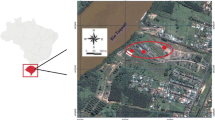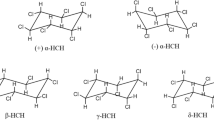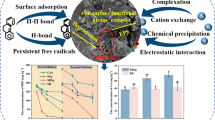Abstract
Treatability studies in real contaminated soils are essential to predict the feasibility of microbial consortium augmentation for field-scale bioremediation of contaminated sites. In this study, the biodegradation of a mixture of seven PAHs in a manufactured gas plant (MGP) soil contaminated with 3967 mg kg−1 of total PAHs using novel acid-, metal-tolerant, N-fixing, P-solubilizing, and biosurfactant-producing LMW and HMW PAH-degrading bacterial combinations as inoculums was compared in slurry- and solid-phase microcosms over natural attenuation. Bioaugmentation of 5 % of bacterial consortia A and N in slurry- and solid-phase systems enhanced 4.6–5.7 and 9.3–10.7 % of total PAH degradation, respectively, over natural attenuation. Occurrence of 62.7–88 % of PAH biodegradation during natural attenuation in soil and slurry illustrated the accelerated rate of intrinsic metabolic activity of the autochthonous microbial community in the selected MGP soil. Monitoring of the total microbial activity and population of PAH degraders revealed that the observed biodegradation trend in MGP soil resulted from microbial mineralization. In the slurry, higher biodegradation rate constant (k) and lower half-life values (t 1/2) was observed during bioaugmentation with consortium N, highlighting the use of bioaugmentation in bioslurries/bioreactor to achieve rapid and efficient bioremediation compared to that of a static solid system. In general, natural attenuation was on par with bioaugmentation. Hence, depending on the type of soil, natural attenuation might outweigh bioaugmentation and a careful investigation using laboratory treatability studies are highly recommended before the upscale of a developed bioremediation strategy to field level.




Similar content being viewed by others
References
Adam, G., & Duncan, H. (2001). Development of a sensitive and rapid method for the measurement of total microbial activity using fluorescein diacetate (FDA) in a range of soils. Soil Biology and Biochemistry, 33, 943–951.
Alexander, M. (1999). Biodegradation and bioremediation (pp. 195–199). London, England: Academic press.
Alexander, M. (2000). Aging, bioavailability and overestimation of risk from environmental pollutants. Environmental Science and Technology, 34, 4259–4265.
Bento, F. M., Camargo, F. A., Okeke, B. C., & Frankenberger, W. T. (2005). Comparative bioremediation of soils contaminated with diesel oil by natural attenuation, biostimulation and bioaugmentation. Bioresource Technology, 96, 1049–1055.
Boonchan, S., Britz, M. L., & Stanley, G. A. (2000). Degradation and mineralization of high-molecular-weight polycyclic aromatic hydrocarbons by defined fungal-bacterial cocultures. Applied and Environmental Microbiology, 66, 1007–1019.
Bossert, I. D., & Bartha, R. (1986). Structure-biodegradability relationships of polycyclic aromatic hydrocarbons in soil. Bulletin of Environmental Contamination and Toxicology, 37, 490–495.
Cameotra, S. S., & Bollag, J. M. (2003). Biosurfactant-enhanced bioremediation of polycyclic aromatic hydrocarbons. Critical Reviews in Environmental Science and Technology, 33, 111–126.
Chen, S. H., & Aitken, M. D. (1999). Salicylate stimulates the degradation of high-molecular weight polycyclic aromatic hydrocarbons by Pseudomonas saccharophila P15. Environmental Science and Technology, 33, 435–439.
Collina, E., Bestetti, G., Di Gennaro, P., Franzetti, A., Gugliersi, F., Lasagni, M., & Pitea, D. (2005). Naphthalene biodegradation kinetics in an aerobic slurry-phase bioreactor. Environmental International, 31, 167–171.
Desai, A. M., Autenrieth, R. L., Dimitriou-Christidis, P., & McDonald, T. J. (2008). Biodegradation kinetics of select polycyclic aromatic hydrocarbon (PAH) mixtures by Sphingomonas paucimobilis EPA505. Biodegradation, 19, 223–233.
Doick, K. J., & Semple, K. T. (2003). The effect of soil: water ratios on the mineralisation of phenanthrene: LNAPL mixtures in soil. FEMS Microbiology Letters, 220, 29–33.
Edgehill, R. U. (1999) Bioremediation by Inoculation with Microorganisms. Bioremediation of contaminated soils. Agronomy monograph no. 37, Soil Science Society of Americam Madison, WI, pp. 289–295.
Ho, C. H., & Banks, M. (2006). Degradation of polycyclic aromatic hydrocarbons in the rhizosphere of Festuca arundinacea and associated microbial community changes. Bioremediation Journal, 10, 93–104.
Huesemann, M. H., Hausmann, T. S., & Fortman, T. J. (2004). Does bioavailability limit biodegradation? A comparison of hydrocarbon biodegradation and desorption rates in aged soils. Biodegradation, 15, 261–274.
Jacques, R. J., Okeke, B. C., Bento, F. M., Teixeira, A. S., Peralba, M. C., & Camargo, F. A. (2008). Microbial consortium bioaugmentation of a polycyclic aromatic hydrocarbons contaminated soil. Bioresource Technology, 99, 2637–2643.
Juhasz, A. L., Stanley, G. A., & Britz, M. L. (2000). Degradation of high molecular weight PAHs in contaminated soil by a bacterial consortium: Effects on microtox and mutagenicity bioassays. Bioremediation Journal, 4, 271–283.
Kanaly, R. A., & Harayama, S. (2010). Advances in the field of high-molecular-weight polycyclic aromatic hydrocarbon biodegradation by bacteria. Journal of Microbiology and Biotechnology, 3, 136–164.
Li, X., Li, P., Lin, X., Zhang, C., Li, Q., & Gong, Z. (2008). Biodegradation of aged polycyclic aromatic hydrocarbons (PAHs) by microbial consortia in soil and slurry phases. Journal of Hazardous Materials, 150, 21–26.
Lorch, H. J., Benckieser, G., & Ottow, J. C. G. (1995). Basic methods for counting microorganisms in soil water: most probable number (pp. 146–161). New York: Academic Press.
Mao, J., Luo, Y., Teng, Y., & Li, Z. (2012). Bioremediation of polycyclic aromatic hydrocarbon-contaminated soil by a bacterial consortium and associated microbial community changes. International Biodeterioration and Biodegradation, 70, 141–147.
Mueller, J. G., Chapman, P. J., Blattmann, B. O., & Pritchard, P. (1990). Isolation and characterization of a fluoranthene-utilizing strain of Pseudomonas paucimobilis. Applied and Environmental Microbiology, 56, 1079–1086.
Nam, K., Rodriguez, W., & Kukor, J. J. (2001). Enhanced degradation of polycyclic aromatic hydrocarbons by biodegradation combined with a modified Fenton reaction. Chemosphere, 45, 11–20.
Nano, G., Borroni, A., & Rota, R. (2003). Combined slurry and solid-phase bioremediation of diesel contaminated soils. Journal of Hazardous Materials, 100, 79–94.
Pereira Netto, A. D., Moreira, J. C., Dias, A. E. X., Arbilla, G., Ferreira, L. F. V., Oliveira, A. S., & Barek, J. (2000). Evaluation of human contamination with polycyclic aromatic hydrocarbons (PAHs) and their nitrated derivatives (NHPAS): a review of methodology. Quimica Nova, 23, 765–773.
Phale, P. S., Basu, A., Majhi, P. D., Deveryshetty, J., Vamsee-Krishna, C., & Shrivastava, R. (2007). Metabolic diversity in bacterial degradation of aromatic compounds. OMICS, 11, 252–279.
Sabate, J., Vinas, M., & Solanas, A. (2004). Laboratory-scale bioremediation experiments on hydrocarbon-contaminated soils. International Biodeterioration and Biodegradation, 54, 19–25.
Semple, K. T., Dew, N. M., Doick, K. J., & Rhodes, A. H. (2006). Can microbial mineralization be used to estimate microbial availability of organic contaminants in soil? Environmental Pollution, 140, 164–172.
Stringfellow, W. T., & Aitken, M. D. (1995). Competitive metabolism of naphthalene, methylnaphthalenes, and fluorene by phenanthrene-degrading Pseudomonads. Applied and Environmental Microbiology, 61, 357–362.
Thavamani, P., Megharaj, M., & Naidu, R. (2012). Bioremediation of high molecular weight polyaromatic hydrocarbons co-contaminated with metals in liquid and soil slurries by metal tolerant PAHs degrading bacterial consortium. Biodegradation, 23, 823–835.
Thavamani, P., Megharaj, M., & Naidu, R. (2015). Metal-tolerant PAH-degrading bacteria: development of suitable test medium and effect of cadmium and its availability on PAH biodegradation. Environmetal Science and Pollution Research, 22, 8957–8968.
Thiele-Bruhn, S., & Brümmer, G. (2005). Kinetics of polycyclic aromatic hydrocarbon (PAH) degradation in long-term polluted soils during bioremediation. Plant and Soil, 275, 31–42.
van Veen, J. A., van Overbeek, L. S., & van Elsas, J. D. (1997). Fate and activity of microorganisms introduced into soil. Microbiology and Molecular Biology Reviews, 61, 121–135.
Vandermeer, K. D., & Daugulis, A. J. (2007). Enhanced degradation of a mixture of polycyclic aromatic hydrocarbons by a defined microbial consortium in a two-phase partitioning bioreactor. Biodegradation, 18, 211–221.
Wang, J., Xu, H., & Guo, S. (2007). Isolation and characteristics of a microbial consortium for effectively degrading phenanthrene. Petroleum Science, 4, 68–75.
Wang, C., Wang, F., Wang, T., Bian, Y., Yang, X., & Jiang, X. (2010). PAHs biodegradation potential of indigenous consortia from agricultural soil and contaminated soil in two-liquid-phase bioreactor (TLPB). Journal of Hazardous Materials, 176, 41–47.
Acknowledgments
SK thanks the Australian Government, University of South Australia (UniSA), and Cooperative Research Centre for Contamination Assessment and Remediation of the Environment (CRC CARE) for the International Postgraduate Research Scholarship (IPRS) and CRC CARE top-up fellowship during PhD.
Author information
Authors and Affiliations
Corresponding author
Rights and permissions
About this article
Cite this article
Kuppusamy, S., Thavamani, P., Megharaj, M. et al. Bioaugmentation with Novel Microbial Formula vs. Natural Attenuation of a Long-Term Mixed Contaminated Soil—Treatability Studies in Solid- and Slurry-Phase Microcosms. Water Air Soil Pollut 227, 25 (2016). https://doi.org/10.1007/s11270-015-2709-7
Received:
Accepted:
Published:
DOI: https://doi.org/10.1007/s11270-015-2709-7




